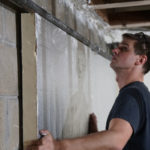Rigid Insulation Board – Basement Insulation
Basement Wall Insulation Using Rigid Foam Board
Best practice for basement wall insulation [best insulating and vapor barrier system] is closed-cell foam, the second-best is using foam board, especially if you’re trying to save money. Using a rigid foam board creates a good vapor barrier along with an insulation layer that won’t promote mold growth. Rigid insulation board is also called Extruded Polystyrene (XPS) insulation.
Basement Insulation Vapor Barrier
The simplest way to prevent this water vapor from entering the space is to prevent air movement [moisture] into the basement by installing a vapor barrier. When properly installed, closed-cell foam (spray or rigid foam board) acts as a vapor barrier and insulates. [poly plastic and Kraft faced insulation is not a good solution for basement vapor barriers. ] The main goal for using rigid foam board against masonry walls is to prevent air vapor movement and mold growth, while it can be the only insulation used in a basement insulation system, it’s often supplemented by fiberglass insulation.
The BEST Rigid Board To Use
- Extruded Polystyrene (XPS) insulation board
- Polyisocyanurate (Polyiso) insulation board
Extruded Polystyrene (XPS) insulation foam boards deliver the long-term stable thermal performance of R-5 per inch. Compared to spray foam, it’s harder to install in awkward areas (for example, in a tight space where a rim joist is close to another parallel joist). Rigid foam is also fussy to install if the rim joists have a lot of wiring and pipe penetrations. But its cheaper and a popular choice if you’re doing a DIY project.
Polyisocyanurate (Polyiso) is a closed-cell, rigid insulation foam board that is bonded to facers on both sides Polyiso is most commonly used due to its fire-retardant properties. Under normal fire conditions, XPS, melts and drips while polyiso, chars over.
The foil facing also helps with the limiting of any moisture travel. Polyiso is commonly used in roof, wall, ceiling and specialty applications within commercial and residential buildings of all types.
Basement Wall Insulation Steps
- Move or Relocate Obstructions
- Install 2″ Foam Insulation Boards
- Seal Vertical Joints With Foil Tape
- Seal Top and bottom Joints, And Other Penetrations With DAP Touch ‘n Foam Polyurethane Foam Sealant.
- Seal the Rim Joist and Sill Plate Area
- Frame Walls
Relocate Any Wall Obstructions
Prior to installing polystyrene insulation boards on your masonry wall, you need to make sure the wall is clear of pipes, electrical wires, and other obstructions. If you do run into obstructions you can start and stop your rigid foam on either side of it and fill that area with spray foam.
Use Insulation Foam Boards [XPS or Polyiso]
Install 2″ insulation foam boards in a vertical orientation, tight to the floor and top of wall or joist bay. See How To Insulate A Rim Joist.
We ensure that the boards fit together using the factory joints, and then return later to tape all seams.
Prior to installing the next insulation board, we add a thick bead of adhesive in the edge groove.
We use DAP DynaGrip construction adhesive for Styrofoam products, and to adhere the boards to masonry walls. DynaGrip is a premium high strength adhesive for heavy interior/exterior construction and remodeling projects.
This multi-material adhesive delivers a powerful instant grab to hold the vertical insulation boards and creates a durable long-lasting adhesion. We apply a zig-zag pattern of 1/2″ bead directly to the wall and press the insulation board in place.
Seal Vertical Joints With Foil Tape
Tape all vertical seams using a foil tape compatible with the foam board. This type of tape has a durable backing, coated with an aggressive acrylic adhesive that offers excellent adhesion, and sealing properties.
Seal Top and Bottom Joints With Foam
Once all of the insulation foam boards are installed to the walls, and the vertical edges have been taped we then seal the top and bottom edge. Using a Pro Series spray gun applicator we completely fill all gaps, remaining penetrations, and any air leaks using DAP Touch ‘n Foam Polyurethane Foam Sealant.
This All-Purpose sealant is a 1-component polyurethane foam sealant that dispenses approved fire-block (ICC-ES ESR-1926) foam.
Seal the Rim Joist and Sill Plate Area
The rim joist is located above grade and for many years we treated it similar to the wall insulation above, by stuffing fiberglass batt insulation in the rim joist bays. This method is no longer recognized as best practice. Best practice for rim joist and sill plate is to seal all cracks against air leakage and then insulate the area. We recommend reading this article to ensure that you have insulated your rim joist properly. Sealing and Insulating Rim Joists – Best Practice
Frame Basement Walls
Install basement walls up tight to the 2″ polystyrene insulation boards. Fiberglass insulation can then be applied to the stud’s walls, to increase the basement insulating R-value.
Rigid Insulation Board – Basement Insulation Video















































